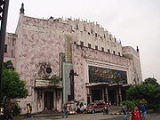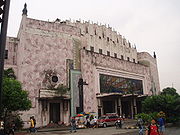
Manila Metropolitan Theater
Encyclopedia

Art Deco
Art deco , or deco, is an eclectic artistic and design style that began in Paris in the 1920s and flourished internationally throughout the 1930s, into the World War II era. The style influenced all areas of design, including architecture and interior design, industrial design, fashion and...
building designed by the Filipino architect Juan M. Arellano, and inaugurated on December 10, 1931, with a capacity of 1670 (846 orchestra, 116 in loge, and 708 in balcony). During the liberation of Manila by the United States and Filipino forces in 1945, the theatre was severely damaged, losing some of its roofing and walls battered. After reconstruction by the Americans it gradually fell into disuse in the 1960s. In the following decade it was meticulously restored in 1978 but again fell into decay.
Recently, a bus terminal and parking building has been constructed at the back of the theatre.
The City of Manila, with the help of the National Commission on Culture and the Arts (NCCA) recently finished a plan of the rehabilitation of the theater.
The sculptures in the façade of the Theater are from the Italian sculptor Francesco Riccardo Monti, who lived in Manila from 1930 until his death in 1958, and worked closely together with Juan M. Arellano.
Highly stylized relief carving of Philippine plants executed by the artist Isabelo Tampingco decorate the lobby walls and interior surfaces of the building.
The theater was again closed in 1996 due to ownership disputes between the city administration and the Government Service Insurance System (GSIS). On June 23, 2010, Former president Gloria Macapagal-Arroyo
Gloria Macapagal-Arroyo
Gloria Macapagal-Arroyo is a Filipino politician who served as the 14th President of the Philippines from 2001 to 2010, as the 12th Vice President of the Philippines from 1998 to 2001, and is currently a member of the House of Representatives representing the 2nd District of Pampanga...
and Manila Mayor Alfredo Lim
Alfredo Lim
Alfredo Siojo Lim is the incumbent Mayor of the City of Manila and a former senator of the Philippines. A widower, he first served as mayor of Manila from 1992 to 1998 and returned to that post after winning in the 2007 mayoral election.-Early life and career:Born on December 21, 1929 in 1324 J...
re-opened the theater after extensive renovations.
The theater is located on Padre Burgos Avenue, near the Manila Central Post Office
Manila Central Post Office
The Manila Central Post Office is the central post office of the city of Manila, Philippines. It is the head office of the Philippine Postal Corporation, and houses the country's main mail sorting-distribution operations....
.

